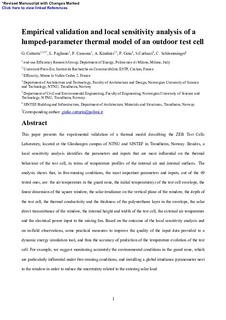| dc.description.abstract | This paper presents the experimental validation of a thermal model describing the ZEB Test Cells Laboratory, located at the Gløshaugen campus of NTNU and SINTEF in Trondheim, Norway. Besides, a local sensitivity analysis identifies the parameters and inputs that are most influential on the thermal behaviour of the test cell, in terms of temperature profiles of the internal air and internal surfaces. The analysis shows that, in free-running conditions, the most important parameters and inputs, out of the 49 tested ones, are: the air temperature in the guard zone, the initial temperature(s) of the test cell envelope, the linear dimension of the square window, the solar irradiance on the vertical plane of the window, the depth of the test cell, the thermal conductivity and the thickness of the polyurethane layer in the envelope, the solar direct transmittance of the window, the internal height and width of the test cell, the external air temperature and the electrical power input to the mixing fan. Based on the outcome of the local sensitivity analysis and on in-field observations, some practical measures to improve the quality of the input data provided to a dynamic energy simulation tool, and thus the accuracy of prediction of the temperature evolution of the test cell. Based on the outcome of the local sensitivity analysis and on in-field observations, we propose some practical measures to improve the quality of the input data provided to a dynamic energy simulation tool, and thus the accuracy of prediction of the temperature evolution of the test cell. For example, we suggest monitoring accurately the environmental conditions in the guard zone, which are particularly influential under free-running conditions, and installing a global irradiance pyranometer next to the window in order to reduce the uncertainty related to the entering solar load. | nb_NO |
